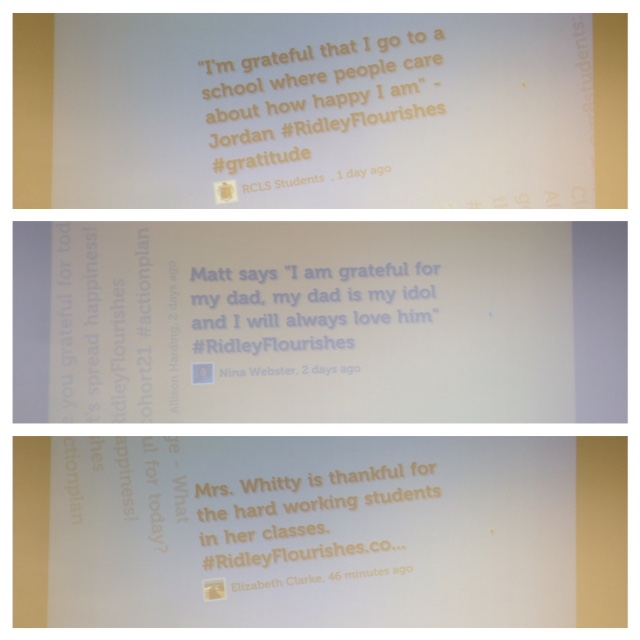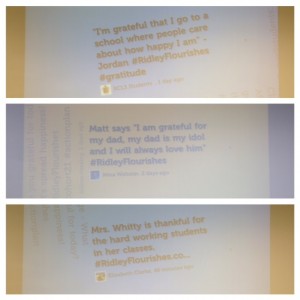First, an update.
Since my last blog post and the completion of Phase 2 of my Action Plan (to create “A Toolkit for Flourishing“), I’ve been working on Phase 3: Implementation.
Initially, I was not exactly sure what Phase 3 would look like. I knew that it would involve sharing out the Toolkit, and I knew that I wanted to actually start practicing positive education – but I wasn’t quite sure how I was going to do this. I worried about not having enough time to execute an idea, or not executing it well.
In hindsight, these concerns led me to Key Learning #1:
Take risks and start small! Meaningful change need not necessarily be a major change. In fact, according to this TedTalk, small changes tend to be more sustainable.
As late March turned to early April, I honed in on a simple idea that would put my Toolkit (or at least one tool from the Toolkit) into action: a Twitter wall that streams gratitude tweets with the hashtag, #RidleyFlourishes. I challenged my homeroom students to List Three Gratitudes every day for at least one month, and encouraged students to share some of these gratitudes via Twitter (using a class Twitter account). I also threw this challenge out to the wider Ridley community, in hopes that other members of the school would participate. A live stream of these tweets has been displayed (via Visible Tweets) in our Lower School Library and in the Upper School Learning Centre. Students, teachers, and administrators alike have taken on the challenge!
In an effort to measure the impacts of this challenge, I had my homeroom students complete a questionnaire – known as the “Flourishing Scale” – before beginning the challenge. They will complete the same questionnaire at the end of the month, and I will compare the two sets of data.
I am pretty pleased with how Phase 3 is going so far – but I cannot take credit for it! I would not have developed or executed this initiative without the help of some friends and fellow Cohort 21ers (especially, @dneville, @gnichols & @shelleythomas!) – which brings me to Key Learning #2:
Go public! Be brave enough to put your ideas out there – even if they’re early ideas that aren’t yet fully developed – via F2F conversations or social media. You never know what great feedback or new ideas you might get back.
After setting up the gratitude challenge and the Tweet wall, I thought the bulk of my “job” was done; I had overcome the challenge of implementing Phase 3. I quickly realized, however, that there was much larger challenge to tackle: if I want my students to flourish, I too need to pursue flourishing. “Action speaks louder than words,” as they say. Hence, Key Learning #3:
Model flourishing (or whatever your goal may be)!
I’ve taken the gratitude challenge alongside my students, and I’ve been sharing some of my gratitudes on Twitter as well. It’s one thing to research and talk about flourishing, but it’s quite another thing to actually live it. This perhaps, will be my greatest challenge (not to say that I am unhappy, but I could certainly work towards increasing my overall well-being).
One thing that I am sure of – a sort of “unofficial” Key Learning #4 – is that doing this work, and being a part of Cohort 21, has absolutely helped me on my personal journey towards flourishing.
So thank you, Cohort 21, for an incredible year. I am truly grateful to have been a part of this experience. I look forward to continuing the journey.
Check out my “Cohort 21 Reflection: A Toolkit for Flourishing” Prezi presentation here!


I LOVE your presentation! It is so beautiful and engaging. What a great community building project and a fun way to teach students to respect and appreciate each other. I also love how it focuses on thankfulness instead of achievement. The students must feel so valued!